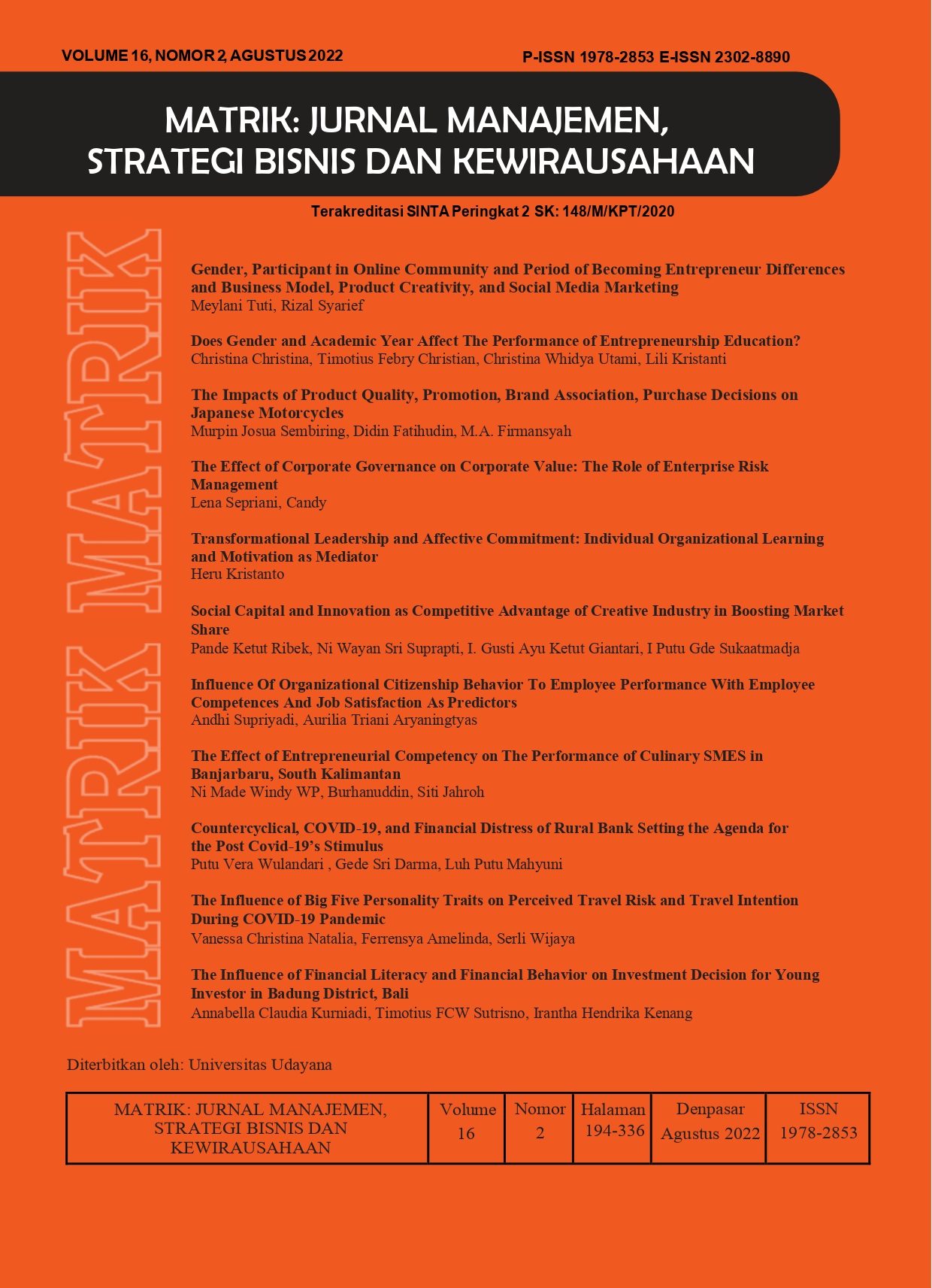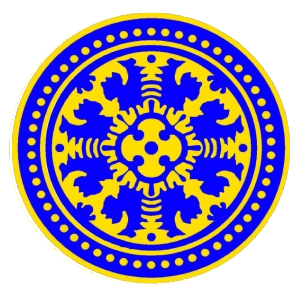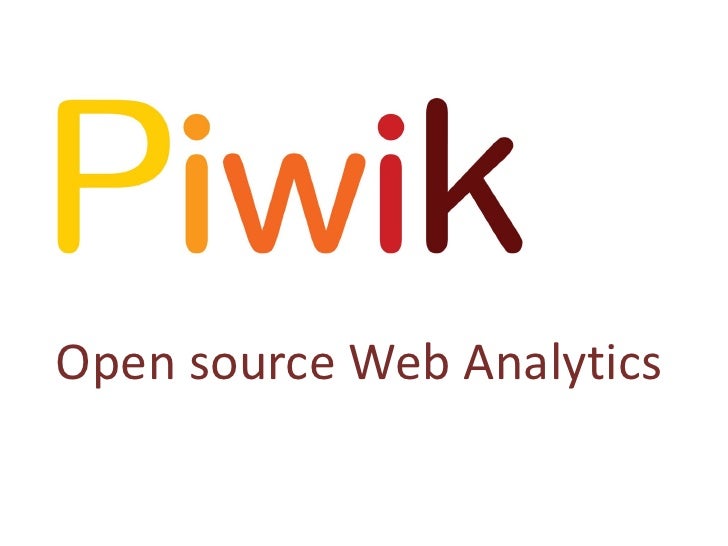Social Capital and Innovation as Competitive Advantage of Creative Industry in Boosting Market Share
Abstract
This study aims to determine social capital and innovation in increasing competitive advantage to achieve marketing performance in the traditional sculpture industry in Indonesia. The quantitative method with the population in this study is a sculpture entrepreneur in Gianyar and a sample of 130 entrepreneurs. The analysis technique uses SEM-PLS 3.0. The results of the study show that social capital and continuous innovation have a positive and significant effect on competitive advantage, social capital has a non-significant positive effect on marketing performance, innovation has an insignificant positive effect on marketing performance, competitive advantage has a significant positive effect on marketing performance, competitive advantage fully mediates social capital.
Downloads
References
Andrevski, G., and Ferrier, W. J. (2019). Does it pay to compete aggressively? Contingent roles of internal and external resources. Journal of Management, 45(2), 620-644.
Ardyan, E. (2016). Market sensing capability and SMEs performance: the mediating role of product innovativeness success. DLSU Business and Economics Review, 25 (2), 79-97.
Asashi, T. and Sukaatmadja, I. P. G. (2017). The Role of Product Innovation in Mediating the Effect of Market Orientation on Marketing Performance. E-Journal of Management, 6(4), 1816-1845.
Bahren, B., Ramadhani, I. and Suroso, E. (2019). Building Competitive Advantage Through Product Innovation, Process Innovation, Marketing Innovation and Organizational Innovation to Improve Company Performance. Journal of Management Economics, 4(1), 8-18.
Baxter, G. (2019). Capturing and Delivering Competitive Advantage in the Japan to Europe and Europe to Japan Air Cargo Markets: The Case of the ANA Cargo and Lufthansa Cargo AG Strategic Joint Venture. MAD-Magazine of Aviation Development, 7(2), 6-21.
Bekmezci, M. (2015). Companies’ profitable way of fulfilling duties towards humanity and environment by innovation. Procedia-Social and Behavioral Sciences, 18(1), 228-240.
Chin, W. W. (2010). How to write up and report PLS analyses. In V. Esposito Vinzi, W. W. Chin, J. Henseler, & H. Wang (Eds.), Handbook of partial least squares: concepts, methods and applications in marketing and related fields (655–690). Berlin: Springer.
Coleman, J. S. (2008). Fundamentals of Social Theory Translated by Imam Muttaqien, Derta Sri Widowati, and Siwi Purwandari.
Cyril, Y., Samuel, A., GomamGoyit, M., & Dakung, R. J. (2019). Innovative Service Delivery and Competitive Advantage of Small Scale Hotels in Nigeria: The Moderating Role of Opportunity Connectedness. International Journal of Managerial Studies and Research, 7(6), 22-24.
Dewi, P. S. A., and Suprapti, N. W. S. 2018. Building Customer Loyalty Through Satisfaction Influenced by Product Quality, Price Perception and Brand Image (Study on Oppo Brand Smartphone Products). Matrix: Journal of Management, Business Strategy and Entrepreneurship, 12(2), 87-98.
French, J. R., Raven, B., and Cartwright, D. (1959). The bases of social power. Classics of organization theory, 7, 311-320.
Ghozali, I., and Latan, H. (2013). Partial Least Square: Konsep Aplikasi Path Modelling XLSTAT. Semarang: Badan Penerbit Universitas Diponegoro.
Giantari, I.G.A.K. and Sukaatmadja, I.P.G. (2021), "Effects of environmental orientation, green marketing mix and social capital on the competitive advantage of real estate developers in Bali", Property Management, 32(2), 193-209.
Hamdoun, M., Achabou, M.A. and Dekhili, S. (2022), "Could CSR improve the financial performance of developing countries’ firms? Analyses of mediating effect of intangible resources", European Business Review, 34 (1), 41-61.
Jeong, H. J. (2020). The Roles of Self-identity Cues and Public Self-consciousness in Volunteering for Socially Stigmatized Causes on Social Media. Journal of Nonprofit & Public Sector Marketing, 32(1), 47-72.
Kadarningsih, A. (2013). Competitive Advantage; The Affecting Factors and Its Impact on Selling-In Performance (Studies on Patronage Outlets PT. Indosat Semarang). In International Conference On Law, Business and Governance (ICon-LBG) Vol. 1.
Khoirrini, L., and Kartika, L. (2014). The Effect of Human Capital and Social Capital on Performance (Case Study of Food and Beverage Small and Medium Enterprises (UKM) in Bogor City). Journal of Management and Organization, 5(3), 244-257.
Killa, Maklon Felipus. (2014). Effect of Entrepreneurial Innovativeness Orientation, Product Innovation, and Value Co-Creation on Marketing Performance. Journal of Research in Marketing, 2 (3), 198-204.
Kingshott, R. P., Sharma, P., Sima, H., and Wong, D. (2020). The impact of psychological contract breaches within east-west buyer-supplier relationships. Industrial Marketing Management, 89, 220-231.
Kuncoro, W. and Suriani, W.O. (2017). Achieving sustainable competitive advantage through product innovation and market driving. Asia Pacific Management Review 23(3): 186–193.
Liu, C.-H.(S). (2021), "Creating competitive advantage through network ties, entrepreneurial orientation and intellectual capital", Management Decision, 59(9), 2238-2263.
Prasetya, I. S., Sudarmawan, A., and Sudiarta. I.W. (2019). The Kamasan Puppet Painting Skill Reduction System By I Nyoman Mandra. Undiksha Journal of Fine Arts Education, 9(1), 1-12.
Raven, B. H. (2008). The bases of power and the power/interaction model of interpersonal influence. Analyses of social issues and public policy, 8(1), 1-22.
Rehman, S.U., Bresciani, S., Ashfaq, K. and Alam, G.M. (2021), "Intellectual capital, knowledge management and competitive advantage: a resource orchestration perspective", Journal of Knowledge Management, Vol. ahead-of-print No. ahead-of-print. https://doi.org/10.1108/JKM-06-2021-0453
Ribek, P. K. (2019). Competitive Strategy Based on Innovation of Products and Implications To Marketing Performance To Improv Sales In Corporate Product Company In Bali. In The 9th International Conference Rural Research and Planning Group, 279-286.
Ribek,P, K., Suprapti, N, W, S., Giantari, I, G, A, K., and Sukaatmadja, I, P, G (2021) Consciousness Value of Social Capital to Increase Competitive Advantage in The Art Industry in Bali. Review of International Geographical Education (RIGEO),11(9),2856-2871.Doi: 10.48047/rigeo.11.09.253
Riches, S., Maskey, R., Dishman, P., Benjamin MBE, J., Waddingham, R., Tebrook, C., and Fisher, H. L. (2019). Development, implementation and evaluation of Altered States of Consciousness: an immersive art exhibition designed to increase public awareness of psychotic experiences. Arts & health, 11(2), 104-122.
Rodger, J. A. (2019). Quantum IS: A qualia consciousness awareness and information theory quale approach to reducing strategic decision-making entropy. Entropy, 21(2), 125.
Salehi, M., Fahimi, M. A., Zimon, G., & Homayoun, S. (2021). The effect of knowledge management on intellectual capital, social capital, and firm innovation. Journal of Facilities Management.
Sherlin, I. (2016). The Effect of Product Innovation and Marketing Performance on Competitive Advantage (Case Study of Kerinci Batik Small and Medium Industry). Benefita Benefits Journal: Development Economics, Business Management & Accounting, 1(3), 105-112.
Sholekhah, I. M., Widodo, J., and Wahyono, W. (2020). The Effect of Social Capital and Learning Organization on Marketing Performance Through the Marketing Strategy. Journal of Economic Education, 9(1), 1-8.
Sugiyanto, E. K., & Marka, M. M. (2017). Modal Sosial dan Human Capital Sebagai Alat Untuk Meningkatkan Kinerja Pemasaran. Jurnal Manajemen dan Kewirausahaan, 5(2), 36-42.
Syahra, R. (2003). Modal sosial: Konsep dan aplikasi. Jurnal Masyarakat dan Budaya, 5(1), 1-22..
Tuominen, T., Tuominen, P., Tuominen, H., and Jussila, I. (2013). Social capital: A source of sustained competitive advantage for consumer co-operatives. International Business Research, 6(12), 60-73.
Urbancova, H. (2013). Competitive advantage achievement through innovation and knowledge. Journal of competitiveness, 5(1). 82-96
Utaminingsih, A. (2016). The effect of market orientation, innovation, and creativity in marketing strategies on marketing performance of rattan craft SMEs in Teluk Wetan village, Welahan, Jepara. Media Economics and Management, 31(2).77-87
Wang, H., Gao, S., Yin, P., and Liu, J. N. K. (2017). Competitiveness analysis through comparative relation mining: evidence from restaurants’ online reviews. Industrial Management and Data Systems,. , 117(4), 672-687.
Widjajanti, K., Sugiyanto, E. K., and Marka, M. M. (2017). Marketing Performance Development Strategy Through Human Capital And Social Capital With Innovation Capability As Mediating Variable. Journal of Socio-Cultural Dynamics, 18(1), 95-108.
Widyanti. (2015). The Influence of Motivation and Organizational Culture on Employee Performance at the Investment Agency and Integrated Licensing Services of Jepara Regency. Journal of Public Policy and Management Review. 4,(1).1-186.
 This work is licensed under a Creative Commons Attribution-ShareAlike 4.0 International License.
This work is licensed under a Creative Commons Attribution-ShareAlike 4.0 International License.

















